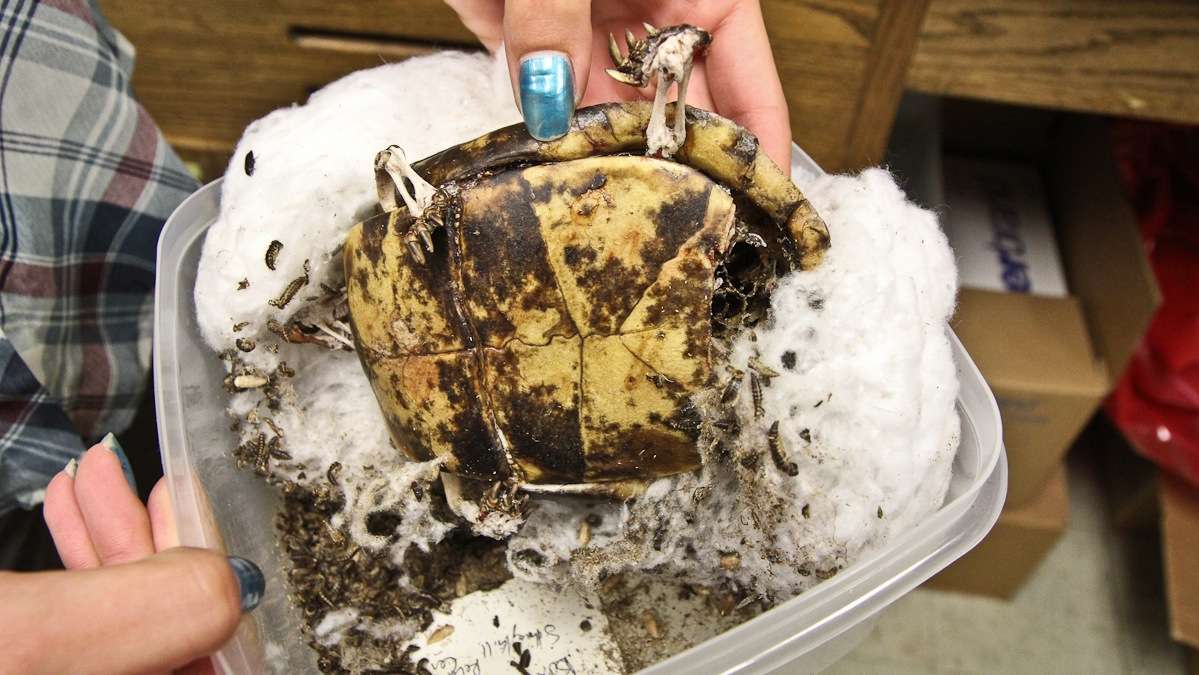The role of flesh-eating beetles in forensics and bone research at Arcadia University
Listen-

-

-

Beetles clean the flesh off of a turtle specimen at Arcadia University. (Kimberly Paynter/WHYY)
-

-

-

-

-

-

-

The thought of flesh-eating beetles might turn your stomach, or send shivers down your spine.
But those feelings might – might – change if you knew how students and professors at Glenside’s Arcadia University are using these pushpin-sized bugs, more commonly known as carpet beetles.
In a tiny lab inside Boyer Hall, is a white, jam-packed freezer that’s full of dead, wild animals that’ll be soon be lunch for the beetles.
There are white rats, red-tailed hawks, a tarantula and lots of turtles.
After being defrosted in warm water, the gutted specimens are tucked into Tupperware containers teeming with hundreds of beetles. It takes just days for a skeleton to emerge from fur and flesh.
Skeleton preparation
Professor Tobias Landberg started the beetle colony two months ago to help prepare bones for a new educational archive.
“I’ll be teaching a vertebrate biology class in the near future that’s going to use this collection at its core for students to be able to do research projects – measure the bones, look at pathologies, compare different species,” he said.
Down the road, Landberg hopes the bones will be used to look at how a given animal has changed over time.
The beetles only eat dead flesh. And they have their favorites.
“We’ve had some mourning doves that came in recently and they just hate these mourning doves for whatever reason. I think it’s because they’re really lean. But man you give them a squirrel or a deer and they go nuts, they get really happy,” said Landberg.
Once the beetles have had their fill, the bones are de-greased in ammonia before being dried on a rack.
As part of her senior thesis, Olena Kostyshak is piecing together a fox skeleton bone by bone.
“I was one of those weird children always playing with dead things,” said Kostyshak.
For her, the tedious, delicate work is kind of like a training ground for a career in forensics.
“A lot of the times you find some bones, you don’t find all of them and you have to piece it together or sometimes you find part of the body, again, could have been scavenged by something. So definitely a connection and little mystery, little puzzle,” she said.
Connection to forensics
In another lab upstairs, a different set of beetles are being used to potentially give homicide investigators another tool to solve their cases.
There, the bugs are doing some of the gritty work tied to a new research project that’s using rats to look at how long drugs stay in bones after death.
In some cases, bone is the only way to know if someone has, for example, been poisoned.
“If we can detect drugs in the bone matrix then that might give us an indication of drugs that were administered just prior to death,” said Karen Scott, who heads Arcadia’s forensics program.
Scott is looking at drugs like methamphetamines and ketamine, a horse tranquilizer that some use recreationally.
She’s also analyzing the beetles themselves.
Homicide investigators already look at what bugs are crawling on a body and where those bugs are in their lifecycle to help determine how long ago someone has died.
Scott said some drugs speed up growth in insects. That could potentially throw off the number of days detectives think have passed since a murder.
“Say they say their time window is five to eight days but because there’s drugs present, the time window is actually two to six days and they could end up potentially discarding a suspect because they were not in the area at the time or something like that,” she said.
Scott has just started digging into her research. It’ll be months, if not years before it’s complete.
And so it’s safe to say it’ll be some time before the results would potentially become a part of investigations.
One thing, though, is for sure. None of it would be possible without flesh-eating beetles.
WHYY is your source for fact-based, in-depth journalism and information. As a nonprofit organization, we rely on financial support from readers like you. Please give today.




